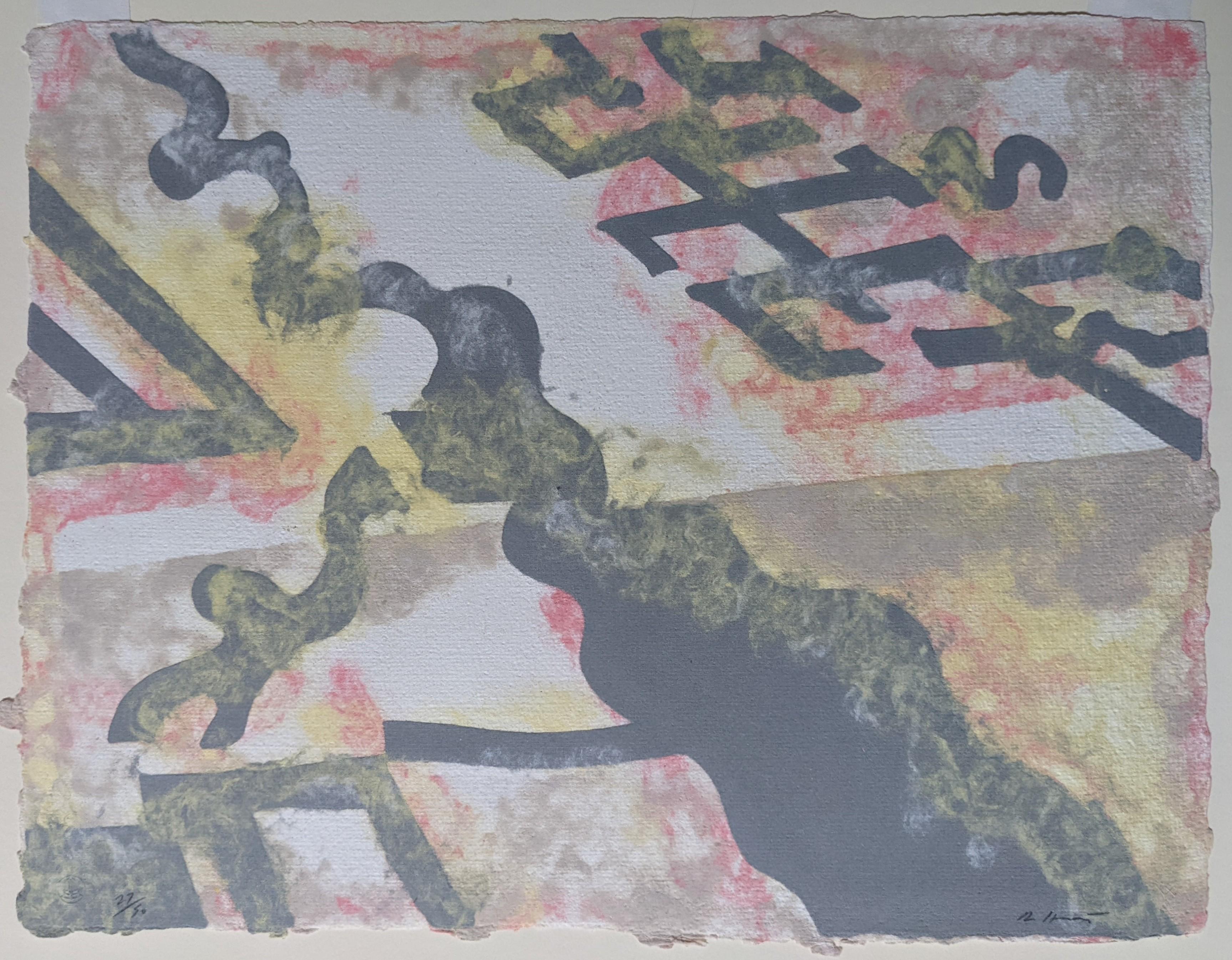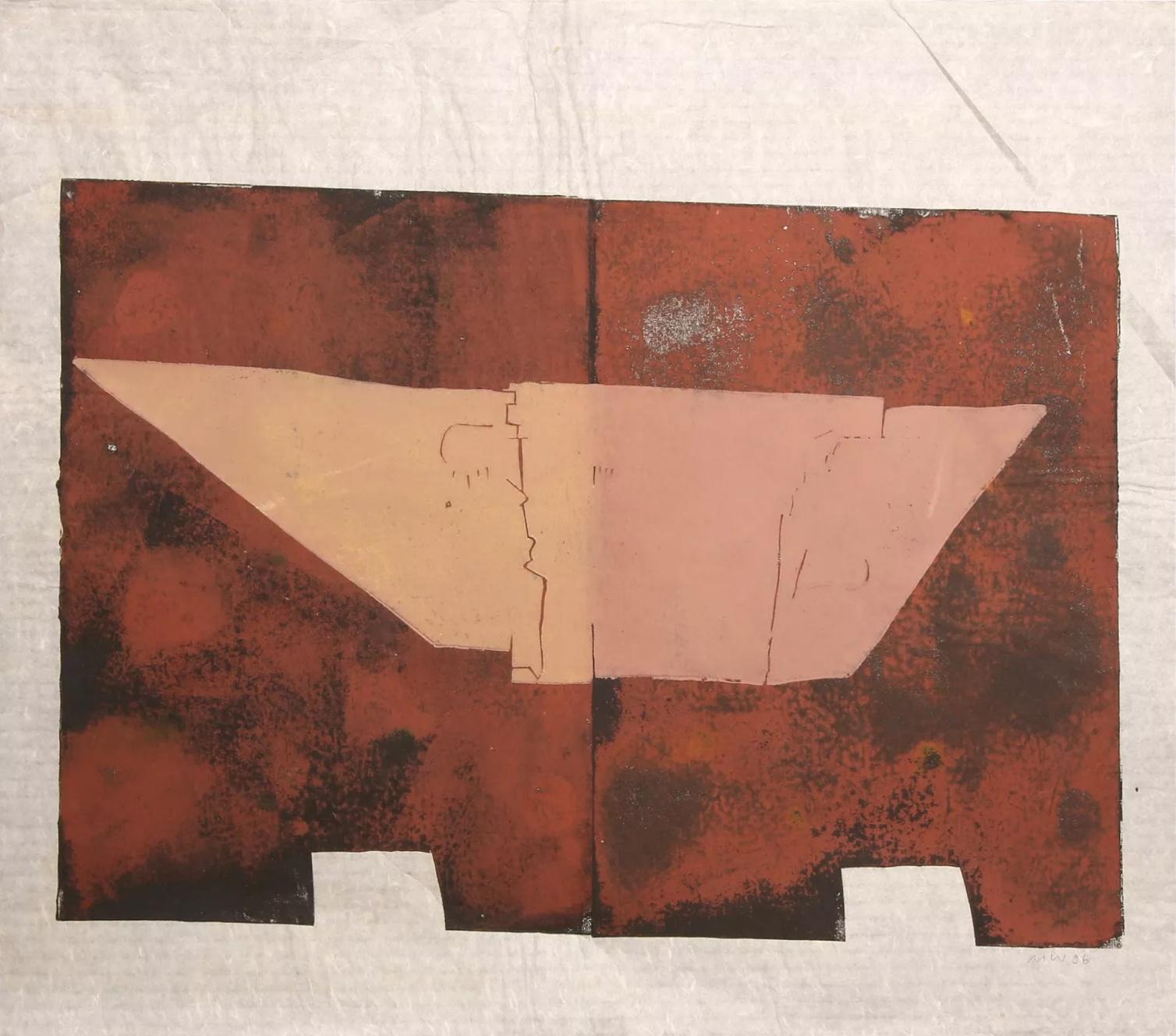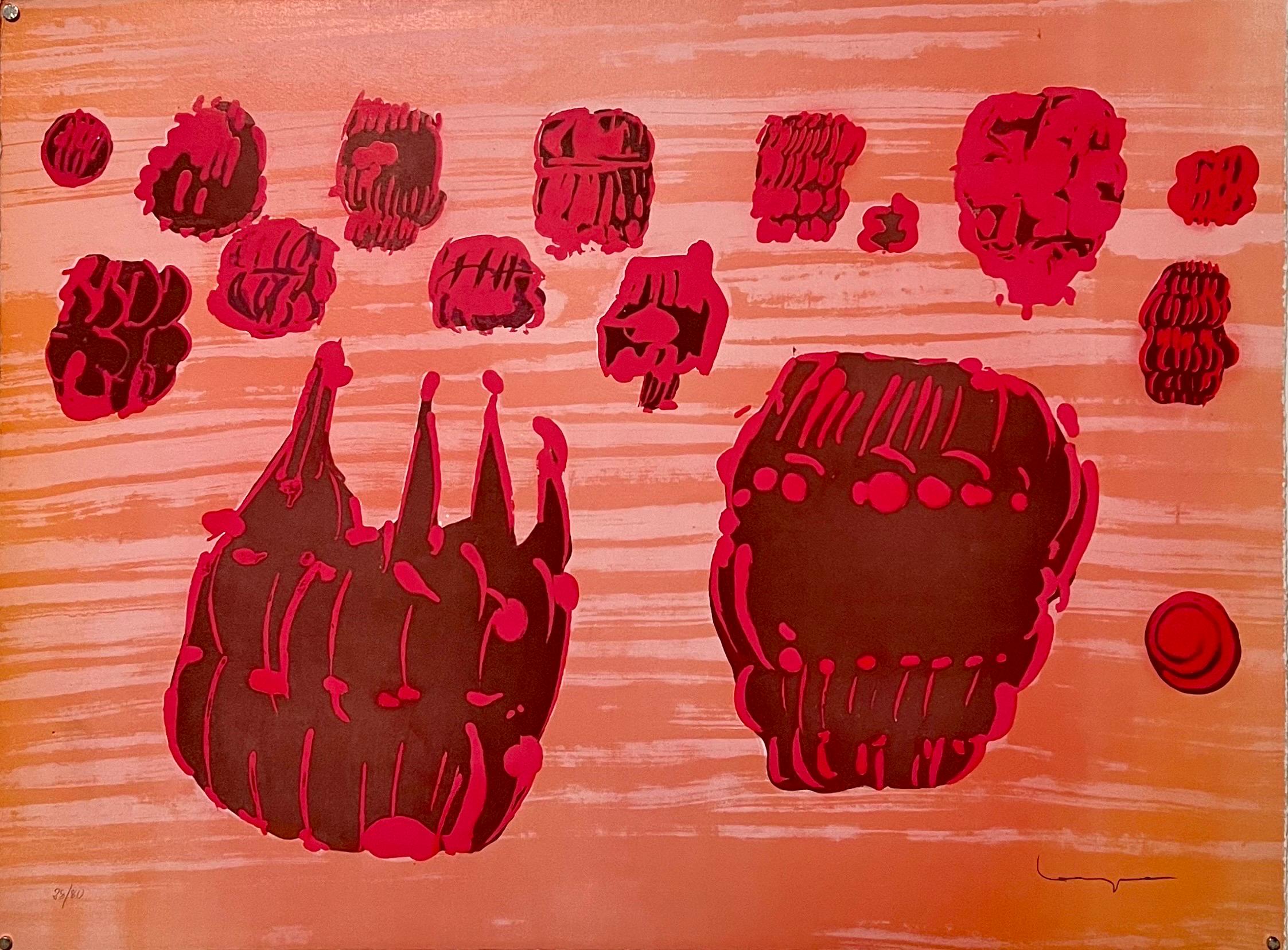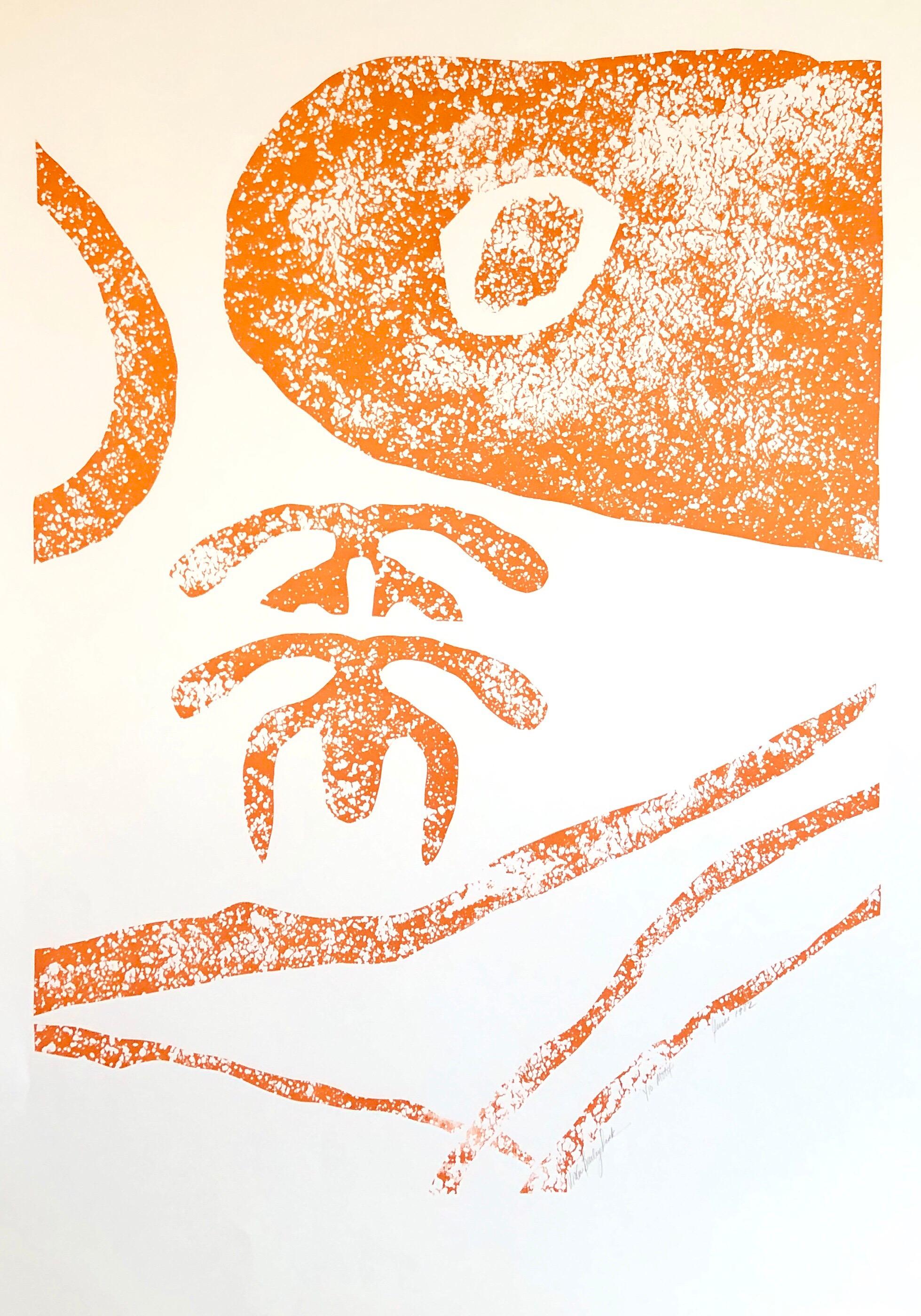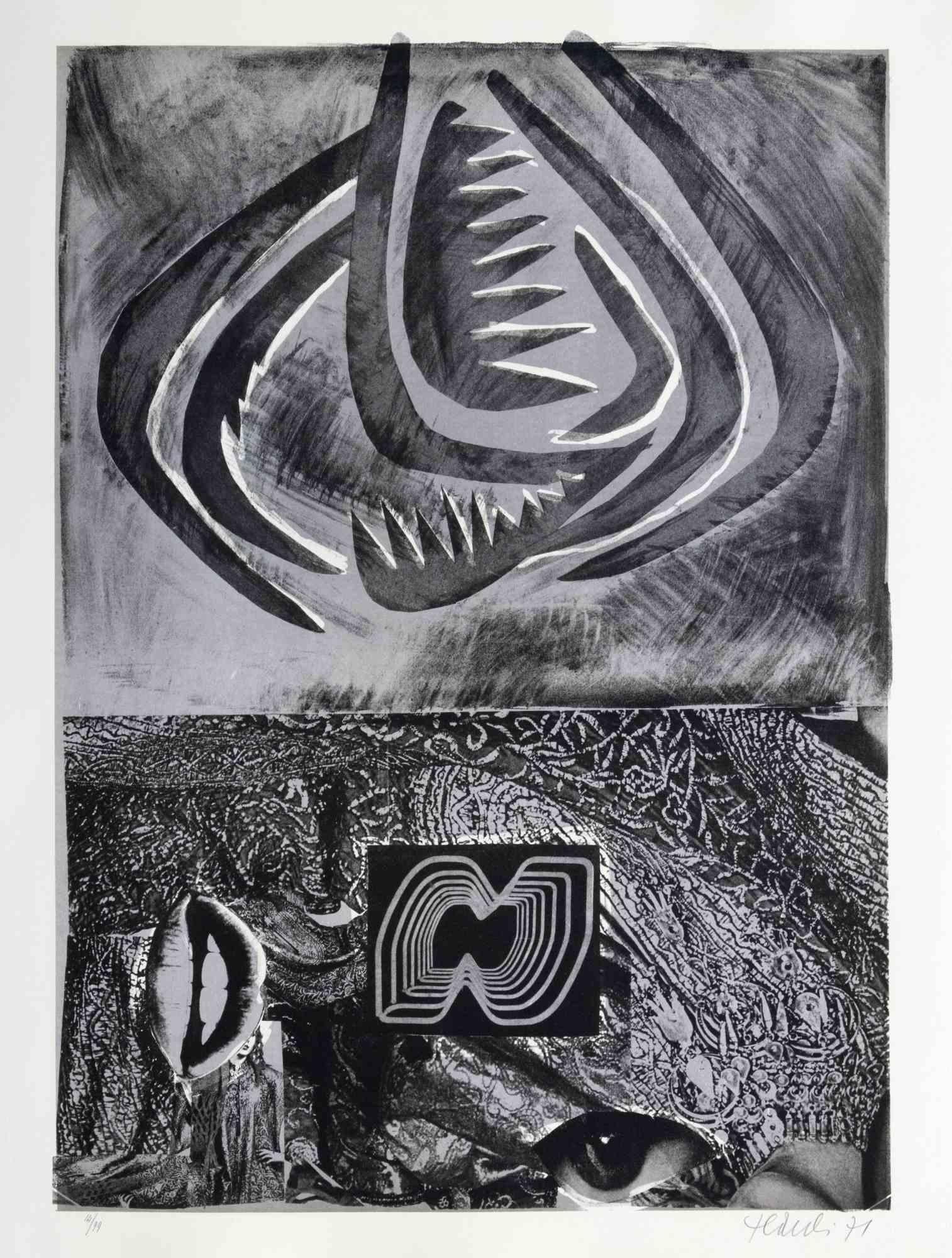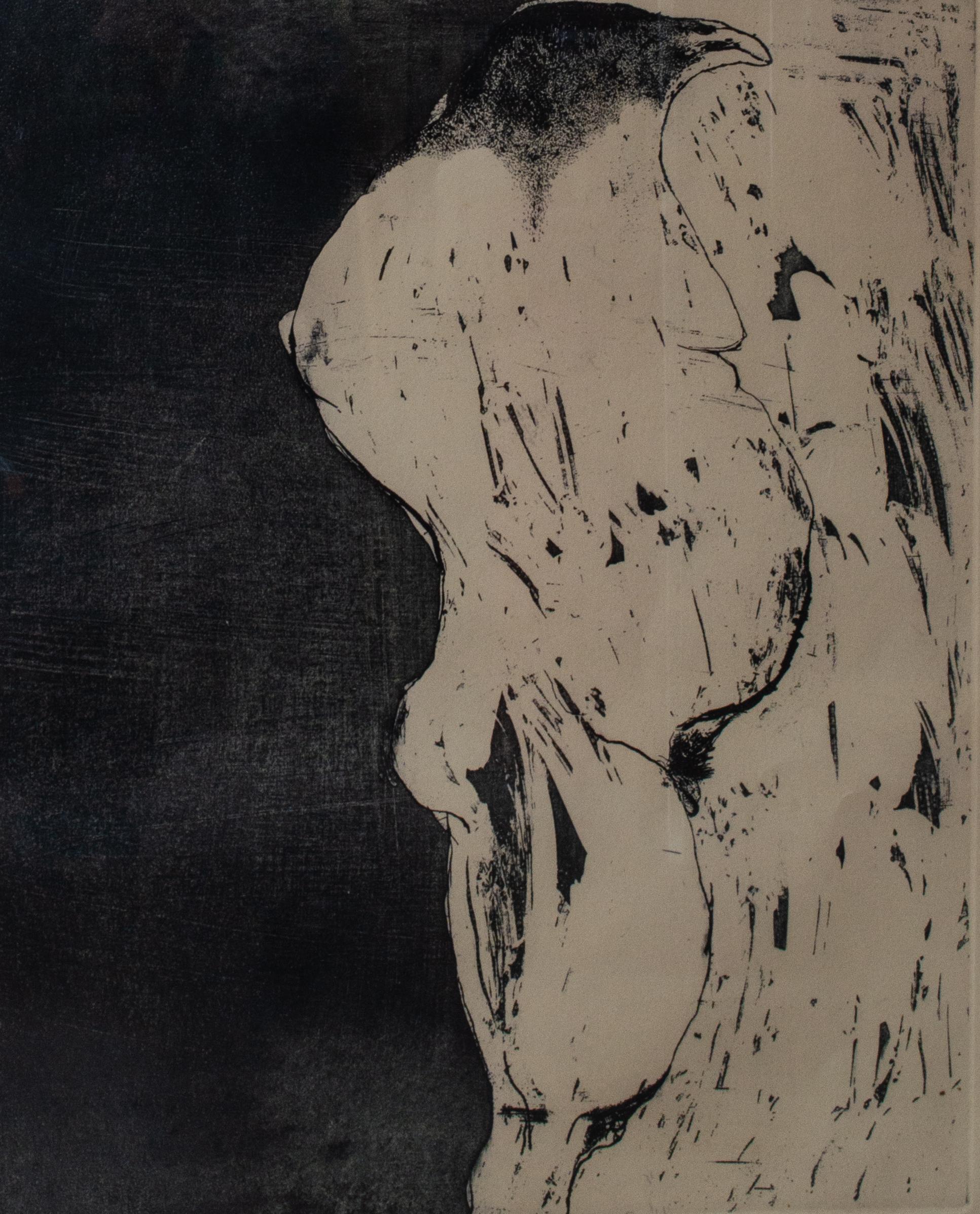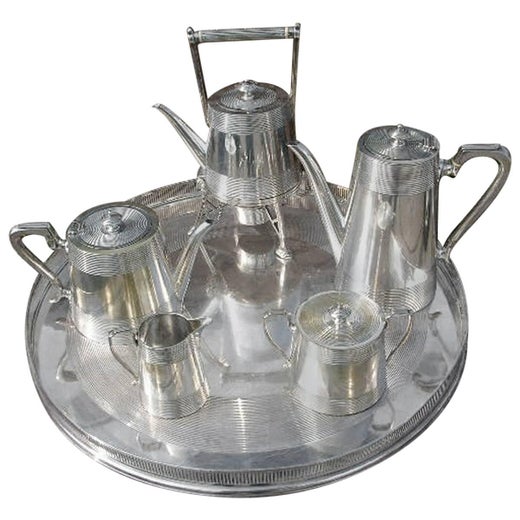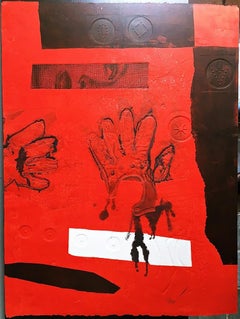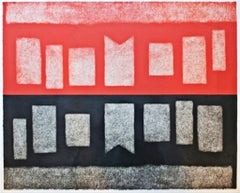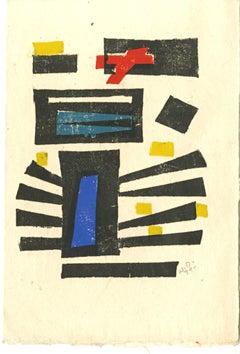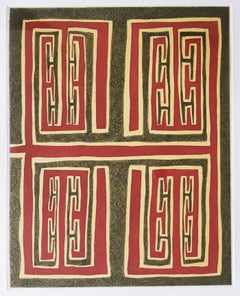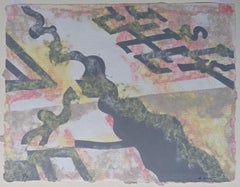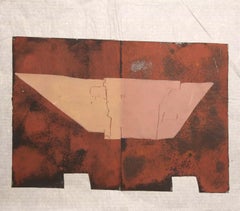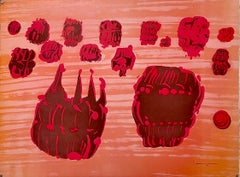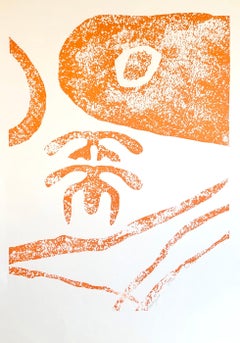Items Similar to African American artist Richard Hunt, Paper piece V, Terracotta Voyage, signed/N
Want more images or videos?
Request additional images or videos from the seller
1 of 7
Richard HuntAfrican American artist Richard Hunt, Paper piece V, Terracotta Voyage, signed/N1978
1978
$3,850
£2,919.29
€3,349.42
CA$5,478.08
A$5,942.48
CHF 3,124.89
MX$72,307.94
NOK 39,066.12
SEK 36,844.15
DKK 25,007.69
About the Item
Richard Hunt
Paper piece V, Terracotta Voyage, 1978
Artwork made exclusively from colored paper pulps, formed, handmade Twinrocker paper made by hand utilizing stencils to apply the wet colored paper pulp to the wet backing layer of pulp for the main image, in order to keep it consistent. The colored washes of pulp vary slightly with each print - similar to ones that are hand colored with watercolor washes.
Signed and numbered 12/50 in graphite front; bears Lakeside Studio blind stamp
18 31/50 × 23 1/2 × 1/5 inches
Unframed
Formed, handmade Twinrocker paper
Signed and numbered 12/50 on the front
Published and printed by Lakeside studio, Lakeside, Michigan with blind stamp
Also accompanied by gallery issued Certificate of Guarantee
Richard Howard Hunt Biography
In the pantheon of 20th-century sculptors, Richard Hunt stood as one of the preeminent masters. Working predominantly in metal, the artist employed an alchemist’s touch to shape, cut, weld or cast his various materials, into sculptures whose fluid, biomorphic forms emerge as if shaped directly from nature. Hunt’s hybrid creations are characterised by a reconciliation and harmonisation of the vital tensions that exist between dualities – the natural and the industrial, the surreal and the abstract, the geometric and the organic. At the core of Hunt’s artistic and philosophical approach was a fundamental concern with freedom; of political and artistic freedom, as well as personal and universal freedom: ‘I am interested more than anything else in being a free person. To me, that means that I can make what I want to make, regardless of what anyone else thinks I should make.’
Born in 1935 on the South Side of Chicago, Hunt’s journey as a sculptor began at the age of 15, working initially with clay in a studio he built in his bedroom, later moving to the basement of his father’s barbershop. In the early 1950s, he studied at the School of the Art Institute of Chicago, where he encountered the work of Spanish sculptor Julio González in the exhibition ‘Sculpture of the Twentieth Century’. González’s forged, hammered and welded metal sculptures became one of the formative influences on the young artist. Inspired in part by González, Hunt transitioned away from soft materials and devoted himself solely to working with metal, teaching himself to solder, and later weld, discarded metal that he scavenged from local scrapyards in Chicago.
With a profound fascination for biological science and the natural world, Hunt meditated on trajectories of metamorphosis, from basic cell division to more complex evolutions. In the artist’s alloying of mechanical and organic vocabularies, Hunt’s abstract sensuosity acknowledges the inherent, unique possibilities of metal, unrivalled by any other sculptural materials be that clay, stone or wood.
The material presence of metal, along with its natural hue variations and tensile properties, enabled him to craft forms that extended into space in ways unattainable with other materials. By repurposing salvaged materials, Hunt’s sculptures exemplify his approach to deconstruction as a means of renewal and growth, a notion further realised through his rearticulation of previous titles or utilisation of a ‘grafting’ method, in which the artist welded parts of old works to cultivate new, hybrid forms. Both approaches suggest a material and discursive life that is blossoming and billowing, affirming life in constant evolution.
‘It is my intention to develop the kind of forms Nature might create if only heat and steel were available to her.’ (Richard Hunt, quoted in exhibition flier, ‘Richard Hunt’, University of Notre Dame Art Gallery, Notre Dame, Indiana, 1966).
In 1957, New York’s Museum of Modern Art (MoMA) acquired Hunt’s steel sculpture, Arachne (1956), earning Hunt national recognition and marking the beginning of his formal career as a sculptor. This achievement, accomplished at the age of 21, coincided with a pivotal juncture in American history – a time marked by racial inequality coupled with the beginnings of the Civil Rights Movement. The brutal, racially charged murder of Emmett Till in 1955, a fellow Chicagoan and African American who became a symbol of the cause, had a profound impact on Hunt. Throughout his life and work, the civil rights movement remained a driving force, shaping Hunt’s artistic process as he commemorated those individuals central to the movement and symbols of resistance. In 1971, at the age of 35, Hunt achieved a historic milestone by becoming the first African American sculptor to have a retrospective at MoMA, New York.
In keeping with his thematic explorations of growth, freedom and the interplay between industrial materials and organic forms, the sculptor sustained an engagement with public spaces. In 1967, Hunt initiated work on Play, a commissioned sculpture that could not be accommodated within his studio. This endeavour led Hunt to collaborate with craftsmen and to use specialised machinery at a metal fabrication shop, marking the beginning of a new chapter in his artistic journey – that of public sculpture. Exploring the possibilities of site-specificity, Hunt shifted his focus to one addressing the interaction of sculpture and the space occupied. In this newfound situatedness, the amorphous and enigmatic rhythms of Hunt’s sculptures became intensified. Notable among Hunt’s public commissions are the welded bronze sculpture, Swing Low (2016), which was commissioned for the National Museum of African American History and Culture in Washington, DC, and The Light of Truth (2021), a monument dedicated to the journalist and civil rights activist Ida B. Wells.
Throughout his seven decade-long career, Hunt staged over 150 solo exhibitions and secured more than 160 large-scale public sculpture commissions worldwide. Among his works, Hunt paid tribute to some of his nation’s greatest heroes, including Martin Luther King, Jr., Mary McLeod Bethune, Jesse Owens, Hobart Taylor, Jr. and Ida B. Wells. In 2022, Barack Obama commissioned Hunt to create a sculptural work for the Obama Presidential Centre, located in Hunt’s hometown of Chicago. Book Bird will grace the Library Reading Garden outside the new Chicago Public Library branch on the campus.
Richard Hunt (1935–2023) was born in Chicago, Illinois, where he lived and worked throughout his life. Throughout his career, he exhibited extensively, including solo exhibitions at KANEKO, Omaha, Nebraska (2022); Norton Simon Museum, Pasadena, California (2022); Art Institute of Chicago, Illinois (2020–21); Georgia Museum of Art, University of Georgia, Athens (2018); Koehnline Museum of Art, Oakton College, Illinois (2018); The Studio Museum in Harlem, New York (2016); Museum of Contemporary Art Chicago, Illinois (2014–15); Galesburg Civic Art Center, Galesburg, Illinois (2013); Brauer Museum of Art, Valparaiso, Indiana (2012); Peninsula Fine Arts Center, Newport News, Virginia (2011); and David Findlay Jr Gallery, New York (2011). His work is held in over 100 public collections including Albright-Knox Art Gallery, Buffalo, New York; Art Institute of Chicago, Illinois; The Cleveland Museum of Art, Ohio; Detroit Institute of Arts, Michigan; Hirshhorn Museum and Sculpture Garden, Smithsonian Institution, Washington, DC; The Metropolitan Museum of Art, New York; Museum of Contemporary Art San Diego, California; MFA Houston, Texas; MoMA, New York; National Museum of African American History and Culture, Washington, DC; Smithsonian American Art Museum, Washington, DC; Storm King Art Center, Mountainville, New York; The Studio Museum in Harlem, New York; and Whitney Museum of American Art, New York, among others.
Hunt is the recipient of numerous awards, among which are the John Simon Guggenheim Memorial Fellowship (1962–63); the Lifetime Achievement Award from the International Sculpture Center (2009); the Fifth Star Award from the City of Chicago (2014); and the Legends and Legacy Award from the Art Institute of Chicago (2022).
-Courtesy White Cube
- Creator:Richard Hunt (1935, African, American)
- Creation Year:1978
- Dimensions:Height: 18.62 in (47.3 cm)Width: 23.5 in (59.69 cm)Depth: 0.2 in (5.08 mm)
- Medium:
- Movement & Style:
- Period:
- Condition:Very good studio condition; all visible imperfections are part of the handmade paper process.
- Gallery Location:New York, NY
- Reference Number:1stDibs: LU1745215805302
Richard Hunt
Abstract sculptor Richard Hunt (B. 1935) is internationally famous for his abstract sculptures and large public works. The Chicago native is considered the most important African-American sculptor of the 20th century and has works held by major museums including the Smithsonian.
About the Seller
5.0
Gold Seller
Premium sellers maintaining a 4.3+ rating and 24-hour response times
Established in 2007
1stDibs seller since 2022
455 sales on 1stDibs
Typical response time: 2 hours
- ShippingRetrieving quote...Shipping from: New York, NY
- Return Policy
Authenticity Guarantee
In the unlikely event there’s an issue with an item’s authenticity, contact us within 1 year for a full refund. DetailsMoney-Back Guarantee
If your item is not as described, is damaged in transit, or does not arrive, contact us within 7 days for a full refund. Details24-Hour Cancellation
You have a 24-hour grace period in which to reconsider your purchase, with no questions asked.Vetted Professional Sellers
Our world-class sellers must adhere to strict standards for service and quality, maintaining the integrity of our listings.Price-Match Guarantee
If you find that a seller listed the same item for a lower price elsewhere, we’ll match it.Trusted Global Delivery
Our best-in-class carrier network provides specialized shipping options worldwide, including custom delivery.More From This Seller
View AllAbstract mixed media lithograph and relief by Spanish artist, Picasso friend S/N
By Antoni Clavé
Located in New York, NY
Antoni Clavé
Untitled, from the Album International 2 Portfolio, 1977
Mixed media: Lithograph in relief
29 1/4 × 19 3/4 inches
Edition 1/50
Signed and number on front
Unframed
This ...
Category
1970s Abstract Abstract Prints
Materials
Mixed Media, Lithograph
Rare Dorothy Dehner Mid century modern sculptural Minimalist lithograph signed/N
By Dorothy Dehner
Located in New York, NY
Dorothy Dehner
Untitled from Lunar Series, 1971
Rare Lithograph on white Arches paper
22 × 27 inches
Pencil signed, dated and numbered; with inscription including unique series numbe...
Category
1970s Abstract Abstract Prints
Materials
Lithograph
Untitled Mid Century Modern Abstract Woodcut
By Werner Drewes
Located in New York, NY
Werner Drewes
Untitled Mid Century Modern Abstract Woodcut, 1974
Woodcut fold-out card on Rives BFK paper with deckled edges
9 1/5 × 6 1/4 inches
Unframed
Rarely seen, this twice sig...
Category
Mid-20th Century Abstract Abstract Prints
Materials
Woodcut
James Siena, geometric abstraction, Christmas print, signed/N, 8/54 Framed
By James Siena
Located in New York, NY
James Siena
Untitled geometric abstraction (The Christmas Print), 2006
3-Color etching on paper with deckled edges
Signed, dated and numbered 8/54 in graphite pencil on the front
Fra...
Category
Early 2000s Abstract Geometric Abstract Prints
Materials
Etching
Alan Shields Peace of the Rock mixed media abstract aquatint silkscreen signed
By Alan J. Shields
Located in New York, NY
ALAN SHIELDS
Peace of the Rock, 1974
Mixed Media Aquatint & Silkscreen
Signed and numbered 14/20 in graphite pencil recto
Frame included: held in original vintage frame
Measurements...
Category
1970s Abstract Geometric Abstract Prints
Materials
Aquatint, Screen
Kimber Smith, Abstract Expressionist Geometric Abstraction signed/n lithograph
By Kimber Smith
Located in New York, NY
KIMBER SMITH
Untitled Abstract Expressionist Geometric Abstraction, 1967
Lithograph on Rives paper
25 × 19 3/5 inches
Signed in silver...
Category
1960s Abstract Geometric Abstract Prints
Materials
Lithograph
You May Also Like
untitled ( Paper Piece I )
By Richard Hunt
Located in New York, NY
Untitled ( Paper Piece I ) 1978 color laminated handmade paper by Richard Hunt produced by Twinrocker Handmade Paper and published by Lakeside Studio. Example number 27 from an editi...
Category
1970s Abstract Abstract Prints
Materials
Handmade Paper
$4,000 Sale Price
20% Off
Untitled (Abstract, Modern, Earthtone, Red, Linocut, ~33% OFF - LIMITED TIME)
Located in Kansas City, MO
Martel Wiegand
Untitled (Abstract, Modern, Beige, Brown, Linocut)
Linoleum Cut on light paper
1996
19.48 x 25.78 inches (49.5 x 65.5 cm)
Edition: Unique
Signed and dated by hand
COA ...
Category
1990s Modern Abstract Prints
Materials
Linocut
Pietro Consagra Italian Mod Abstract Expressionist Forma Brutalist Lithograph
By Pietro Consagra
Located in Surfside, FL
Pietro Consagra (Italian, 1920-2005).
Hand signed in pencil and numbered limited edition color lithograph on Magnani paper.
Embossed stamp with limited edition numbers in pencil to lower left, and having artist pencil signature to lower right.
(from a limited edition of 80 with 15 artist's proofs)
Published by Stamperia 2RC, Rome Italy and Marlborough Gallery, Rome, Italy.
Abstract Modernist work in colors, produced in the style of the Forma art movement of Postwar Italy, of which the artist was a prominent member.
Pietro Consagra (1920 – 2005) was an Italian Post war artist working in painting, printmaking and sculpture. In 1947 he was among the founding members of the Forma 1 group of artists, proponents of structured abstraction.
Consagra was born on 6 October 1920 in Mazara del Vallo, in the province of Trapani in south-western Sicily, to Luigi Consagra and Maria Lentini. From 1931 he enrolled in a trade school for sailors, studying first to become a mechanic, and later to become a captain. In 1938 he moved to Palermo, where he enrolled in the liceo artistico; despite an attack of tuberculosis, he graduated in 1941, and in the same year signed up at the Accademia di Belle Arti, where he studied sculpture under Archimede Campini. After the Invasion of Sicily and the Allied occupation of Palermo in 1943, Consagra found work as a caricaturist for the American Red Cross club of the city; he also joined the Italian Communist Party. Early in 1944, armed with a letter of introduction from an American officer, he travelled to Rome. There he came into contact with the Sicilian artist Concetto Maugeri, and through him with Renato Guttuso, who was also Sicilian and who introduced him to the intellectual life of the city and to other postwar artists such as Leoncillo Leonardi, Mario Mafai and Giulio Turcato. Consagra signed up at the Accademia di Belle Arti di Roma in September 1944 and studied sculpture there under Michele Guerrisi, but left before completing his diploma.
In 1947, with Carla Accardi, Ugo Attardi, Piero Dorazio, Mino Guerrini, Achille Perilli, Antonio Sanfilippo and Giulio Turcato, Consagra started the artist's group Forma 1, which advocated both Marxism and structured abstraction.
Steadily Consagra's work began to find an audience. Working primarily in metal, and later in marble and wood, his thin, roughly carved reliefs, began to be collected by Peggy Guggenheim and other important patrons of the arts. He showed at the Venice Biennale eleven times between 1950 and 1993, and in 1960 won the sculpture prize at the exhibition. During the 1960s he was associated with the Continuità group, an offshoot of Forma I, and in 1967 taught at the School of Arts in Minneapolis. Large commissions allowed him to begin working on a more monumental scale, and works of his were installed in the courtyard of the Foreign Ministry in Rome and in the European Parliament, Strasbourg. His work is found in the collections of The Tate Gallery, London, in Museo Cantonale d'Arte of Lugano and the Museum of Modern Art, Paris, and the National Gallery of Art in Washington, D.C..
Consagra returned to Sicily where he sculpted a number of significant works during the 1980s. With Senator Ludovico Corrao, he helped created an open-air museum in the new town of Gibellina, after the older town had been destroyed in the earthquake of 1968. Consagra designed the gates to the town's entrance, the building named "Meeting" and the gates to the cemetery, where he was later buried.
In 1952 Consagra published La necessità della scultura ("the need for sculpture"), a response to the essay La scultura lingua morta ("sculpture, a dead language"), published in 1945 by Arturo Martini. Other works include L'agguato c'è ("the snare exists", 1960), and La città frontale ("the frontal city", 1969). His autobiography, Vita Mia, was published by Feltrinelli in 1980. In 1989 a substantial retrospective exhibition of work by Consagra was shown at the Galleria Nazionale d'Arte Moderna in Rome; in 1993 a permanent exhibition of his work was installed there. In 1991 his work was shown in the Hermitage Museum in St. Petersburg. In 2002 the Galerie der Stadt Stuttgart opened a permanent exhibition of his work. He was one of ten artists invited by Giovanni Carandente, along with David Smith, Alexander Calder, Arnaldo Pomodoro, Lynn Chadwick, and Beverly Pepper, to fabricate works in Italsider factories in Italy for an outdoor exhibition, "Sculture nella città", held in Spoleto during the summer of 1962. He was included in the The 1962 International Prize for Sculpture the jury included Argan, Romero Brest and James Johnson Sweeney the former director of the Solomon R. Guggenheim Museum in New York. The participants included Louise Nevelson and John Chamberlain for the United States; Lygia Clark for Brazil; Pietro Consagra, Lucio Fontana, Nino Franchina, and Gió Pomodoro for Italy; Pablo Serrano for Spain; and Eduardo Paolozzi, William Turnbull, and Kenneth Armitage for England. Gyula Kosice, Noemí Gerstein, Julio Gero, Naum Knop...
Category
1960s Abstract Expressionist Abstract Prints
Materials
Lithograph
Motif. Abstract, African American Artist Viola Leak Woodcut Silkscreen Print
By Viola Burley Leak
Located in Surfside, FL
Motif (Abstract) in orange abstract.
From the small edition of 10. from 1982. I am not sure if this is a woodcut or woodblock print or a silkscreen screenprint or some combination.
Viola Burley Leak, American (1944 - )
Viola Leak was born in Nashville, Tennessee, she received a B.A. in Art from Fisk University, a B.F.A. in Fashion Design from Pratt Institute, Brooklyn, an M.A. from Hunter College, NY and an M.F.A. in Media from Howard University, Washington, DC. Leak was an art consultant for both the New York State Board of Education and the Metropolitan Museum of Art's Print Department, in addition to working for the Experimental Gallery of Art at the Smithsonian Institute. Her mixed media work often references religious motifs and those of her African-American experience and heritage.
She is a multimedia artist, her works include printmaking, textile designing, soft sculpture, appliqué tapestries, doll making, and multi-media.
Viola has studied with many renowned artists such as Aaron Douglas, Romare Bearden, Robert Blackburn, and Charles White. Her works can be found in the collections of World Federation of United Nations, New York State Office Building, Manufacturers of Hanover Trust Company, Atlanta Life Insurance Company and many more organizations.
Viola's exhibition experience is extensive - more than 100 showings over a decade, national and international. Her quilts exude a miraculous and magical presence. They have traveled in two international shows and three national quilt projects in the past three years.
A proud moment for her was being featured in the December 20, 2000 of the Smithsonian magazine; the article praised her mural "Afro Dance Scan" as one of the outstanding artworks in the "When the Spirit Moves: African American Dance...
Category
1980s Contemporary Figurative Prints
Materials
Screen, Woodcut
Tribal - Lithograph by Nani Tedeschi - 1971
By Nani Tedeschi
Located in Roma, IT
Tribal is an contemporary artwork realized by Nani Tedeschi in 1971.
Black and white lithograph.
Hand signed and dated on the lower margin.
Numbered on the lower margin.
Category
1970s Abstract Abstract Prints
Materials
Lithograph
Leonard Baskin Abstract Woodcut, Signed
By Leonard Baskin
Located in New York, NY
Leonard Baskin (1922-2000)
Untitled, Late 20th Century
Woodcut
Framed: 32 x 24 1/4 x 1/4 in.
Edition 26/50
Signed and numbered lower right
A highly respected draftsman, printmaker, ...
Category
Late 20th Century Abstract Abstract Prints
Materials
Woodcut
More Ways To Browse
Fluid Sculpture
Welded Bronze Sculpture
Sculpture Swing
San Lazaro
Shoichi Hasegawa
Space Invader Print
The Paris Review Print
Tim Walker
Victor Vasarely Vega
Victor Vasarely Zebra
Vintage Band Flyers
Vintage Travel Posters Book
Voyage Around The World Litho
Welcome Mat
Ace Gallery Poster
Alan Cote
Alan Thompson
Alexander Calder Balloons
